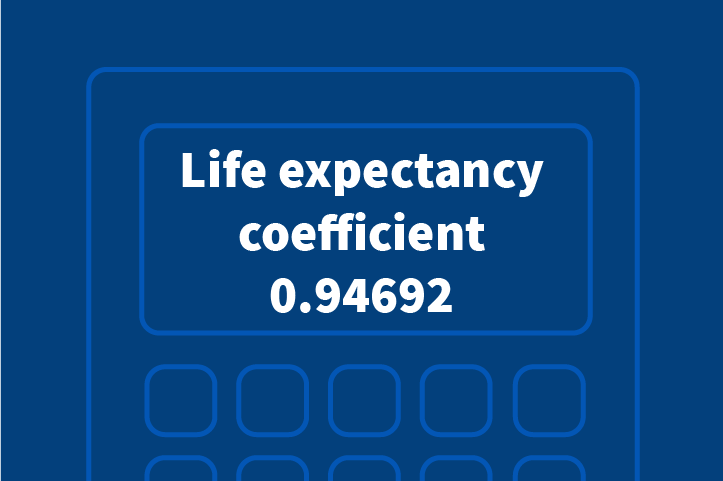Life expectancy coefficient for the 1962 birth cohort confirmed — reduces starting earnings-related pensions less than in 2023

The Ministry for Social Affair and Health has confirmed the life expectancy coefficient for 2024. The coefficient will reduce starting pensions by 5.3 per cent, which is less than in 2023. The lower life expectancy coefficient is due to high mortality during the corona pandemic.
As stated in the Ministry’s decree, the life expectancy coefficient confirmed for those born in 1962 is 0.94692. The value of the coefficient grows compared to the coefficient of 2023, which is exceptional. Until now, the new value of the life expectancy coefficient has always been smaller than in the year before.
The change in the life expectancy coefficient means that the old-age pensions and certain other pensions for those born in 1962 that start in 2024 will be reduced by 5.3 per cent. This is 0.3 per cent less than in 2023.
“The life expectancy coefficient is based on the realised mortality rates of those approaching their retirement age. The life expectancy of those aged 62 decreased for the third year in a row. In other words, the downward trend has continued since the beginning of the corona pandemic”, explains Development Manager Heikki Tikanmäki (Finnish Centre for Pensions).
The life expectancy coefficient is applied when a person takes out their earnings-related pension for the first time. The pension amount listed on the pension record has been multiplied with the estimated life expectancy coefficient.
Life expectancy coefficient curbs the growth of pension expenditure
The life expectancy coefficient introduced in the 2005 pension reform is an automatic stabiliser which adjusts the monthly pension to the general development of life expectancy.
When the pension earned during working life is granted, it is multiplied by the life expectancy coefficient. The coefficient does not change after that. The purpose of the coefficient is, on the one hand, to curb the rising pension expenditure due to extended life expectancy and, on the other, to defer retirement. If the average life expectancy of Finns increases, the value of the life expectancy coefficient decreases. Correspondingly, the value of the life expectancy coefficient increases if life expectancy decreases.
Life expectancy calculated for the 62-year-olds
The life expectancy coefficient is set for each birth cohort at age 62. It is applied to all earnings-related pensions when they start. In recent years, the life expectancy coefficient has reduced starting earnings-related pensions by around 5 per cent.
Confirmed life expectancy coefficients for different age groups in 2019–2024
| Year in which the life expectancy coefficient was determined (at age 62) | Year of birth | Life expectancy coefficient | Effect on starting monthly pension, % |
|---|---|---|---|
| 2024 | 1962 | 0.94692 | -5.3 |
| 2023 | 1961 | 0.94419 | -5.6 |
| 2022 | 1960 | 0.94659 | -5.3 |
| 2021 | 1959 | 0.94984 | -5.0 |
| 2020 | 1958 | 0.95404 | -4.6 |
| 2019 | 1957 | 0.95722 | -4.3 |
The life expectancy coefficient was applied for the first time in 2009 at a value of 1 (1.00000). In 2009, those born in 1947 turned 62.
The Finnish Centre for Pensions calculates the life expectancy coefficient each year. After that, the Ministry of Social Affairs and Health issues a decree to confirm the coefficient. The 2-per-cent interest rate stipulated by the Employees Pensions Act, as well as Statistics Finland’s probability-of-death figures in the mortality statistics for the last five years are used when calculating the coefficient.
Example on how the life expectancy coefficient affects your pension
You were born in 1962. By the time your old-age pension begins, you have accrued a monthly earnings-related pension of 1,800 euros. The confirmed life expectancy coefficient for those born in 1962 is 0.94692. Your accrued pension is multiplied by the life expectancy coefficient of your age group.
€1,800 × 0.94692 = €1,704.46
Your gross pension (pension before tax) is €1,704.46 This means that the life expectancy coefficient reduces your pension by around 5.3 per cent.
What earnings-related benefits are reduced by the life expectancy coefficient?
The life expectancy coefficient reduces
- the old-age pensions that start in 2024 of those born in 1962,
- the partial old-age pensions that start in 2024 of those born in 1963,
- the earned disability pension components of those born in 1962 or later that start in 2024, and
- the surviving spouse’s pensions of deceased, non-retired persons born in 1962 or later that start in 2024.
More information:
